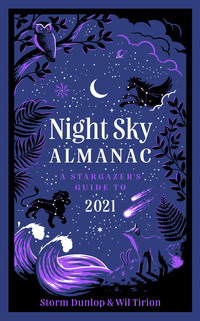
Night Sky Almanac 2021

The northern circumpolar constellations.
For observers slightly farther north, say at 50°N, additional constellations become circumpolar. The most important of these are Perseus, not far from Cassiopeia, and most of which is visible and, farther round, the northern portion of Auriga, with bright Capella (α Aurigae). On the other side of the sky is Deneb, the brightest star in Cygnus, although it is often close to the horizon, especially during the early night during the winter months. Vega (α Lyrae) another of the three stars that form the Summer Triangle is even farther south, often brushing the northern horizon, and only truly circumpolar and clearly seen at any time of the year for observers at 60°N.
Such far northern observers will also find that Castor (α Geminorum) is actually circumpolar, although at times it is extremely low on the horizon. The other bright star in Gemini, Pollux (β Geminorum) is slightly farther south and cannot really be considered circumpolar.

The southern circumpolar constellations
Just as Ursa Major is the key constellation in the northern sky, so is Crux (the Southern Cross) an easily recognized feature of the southern circumpolar sky, although at times it may be brushing the horizon for observers at 30°S – roughly the latitude of Sydney in Australia. This is particularly true in the southern spring. Northeners, new to the southern sky, sometimes mistake the ‘False Cross’, which consists of two stars from each of the constellations of Vela and Carina for the true Southern Cross. Crux itself is accompanied by the clearly visible dark cloud of the ‘Coalsack’ and also the two brightest stars in Centaurus: Rigil Kentaurus and Hadar (α and β Centauri, respectively). Together, the four stars of Crux and the two from Centaurus act as principal guides to the southern constellations.

The southern circumpolar constellations.
Unfortunately, unlike the situation in the north, there is no star conveniently located at the South Celestial Pole (SCP), which lies in a relatively empty region of sky in the faint, triangular constellation of Octans. Octans itself is perhaps best found by using the stars of Pavo as guides. A line from Peacock (α Pavonis) through the second brightest star (β) in that constellation, if extended by about the same amount as the distance between the two stars, points to the ‘base’ of the triangle of Octans.
The main ‘upright’ of Crux, if extended and curving slightly to the right, does point in the approximate direction of the Pole, passing through Musca and the tip of Chamaeleon. However, a better way is to start at Hadar (the star in the bright pair that is closest to Crux), turn at right-angles at Rigil Kentaurus, and following an imaginary line through the brightest star in the small constellation of Circinus and then right across the sky, brushing past the outlying star of Apus, and the star (δ) at the apex of Octans itself. Centaurus is a straggling constellation, with many stars well north of Rigil Kentaurus and Hadar, and some fainter ones that partially enclose Crux. Starting at Crux, and moving clockwise (in the same direction as the sky rotates), we come to the stars of Carina and Vela, both originally part of the large, now obsolete constellation of Argo Navis. Past the False Cross, we come to Canopus (α Carinae), the second brightest star in the sky, which is just circumpolar for observers at 40°S, although occasionally, especially in June, very low over the northern horizon. Lying between Canopus and the SCP is the Large Magellanic Cloud (LMC), a satellite galaxy to our own. It lies across the boundaries of the constellations of Dorado and Mensa.
Olympus Mons, on Mars, is the highest mountain (volcano) in the Solar System. It is about 27 km high (measured as 21,287.4 metres above a datum level) and is roughly the size of Spain.
Continuing round from Canopus we pass the constellations of Dorado, the small constellation of Reticulum and the undistinguished constellation of Horologium, beyond which is Achernar (α Eridani) the brightest star in the long, winding constellation of Eridanus, which actually starts far to the north, close to Rigel in Orion. Between Achernar and the SCP, lies the triangular constellation of Hydrus, next to the constellation of Tucana which contains the Small Magellanic Cloud (SMC).
For observers farther south (at say, 50°S) there are the constellations of Phoenix, followed by the roughly cross-shaped constellation of Grus and the rather faint Indus. For observers at 40°S, the whole of the constellation of Pavo is visible, including its brightest star, Peacock. Farther round there is the constellation of Ara and, for observers farther north at 30°S, Triangulum Australe is fully visible.
Конец ознакомительного фрагмента.
Текст предоставлен ООО «ЛитРес».
Прочитайте эту книгу целиком, купив полную легальную версию на ЛитРес.
Безопасно оплатить книгу можно банковской картой Visa, MasterCard, Maestro, со счета мобильного телефона, с платежного терминала, в салоне МТС или Связной, через PayPal, WebMoney, Яндекс.Деньги, QIWI Кошелек, бонусными картами или другим удобным Вам способом.
Вы ознакомились с фрагментом книги.
Для бесплатного чтения открыта только часть текста.
Приобретайте полный текст книги у нашего партнера:
Полная версия книги
